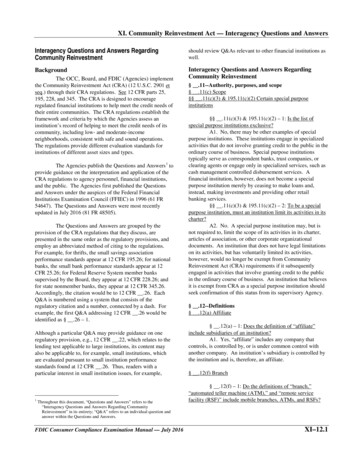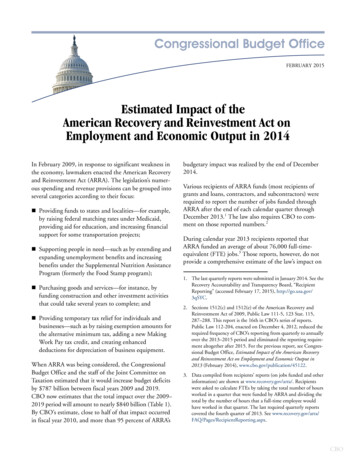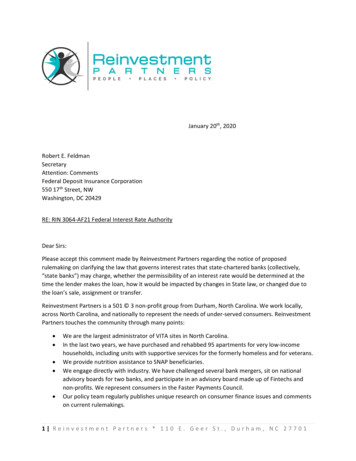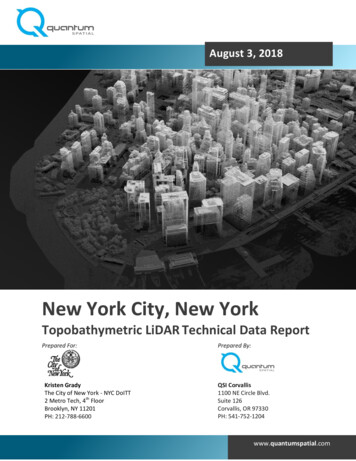
Transcription
New York’s Reinvestment Strategy:Achieving the Triple Aim14
OVERVIEWNew York’s reinvestment strategy will ensure that the full breadth of the MRT recommendations and theACA are successfully implemented. The reinvestment funds are essential given the fiscal challenges still facingNew York State as the nation struggles to escape a weak economy. The following sections are New York’scurrent thoughts on how to utilize the reinvestment funds. New York has identified thirteen new programsthat if implemented as described in this document will ensure that the MRT action plan and the ACA aresuccessfully implemented.New York is interested in using the MRT waiver amendment resources to forge new relationships andpartnerships between providers and stakeholders in order to improve health care delivery and overallpopulation health. The state wants providers to work together across traditional “silos” and developcomprehensive proposals that will address core challenges that exist within specific communities. While thestate will accept applications for waiver funding from single entities the state will provide enhancedconsideration for proposals that are brought by multiple organizations in true partnership especially whenthose partnerships are formed as a result of regional health planning.The state also seeks comprehensive applications from traditional and/or community-based integrated deliverysystems and community-wide partnerships that will seek funding from multiple MRT waiver programs.Comprehensive applications will also be given enhanced consideration especially if they are tied to long termstrategic plans and are well coordinated with other providers/stakeholders in the communities in which theyserve.15
MRT Reinvestment ProgramPrimary Care ExpansionBACKGROUNDIncreasing access to high quality primary care services is essential in developing a community-based healthcare infrastructure which will ensure New York achieves the Triple Aim. As a result of the Affordable CareAct (ACA) and the initiatives of the Medicaid Redesign Team (MRT), New York State’s health care systemhas made significant strides toward these aims. New York’s health care delivery system and its financing areradically changing from the system of just a few years ago. The driving force behind the MRT’s efforts is agrowing Medicaid program in the state that has largely overinvested in expensive institutional care andunderinvested in less costly primary and preventive care. A principal strategy of the MRT has been topromote integrated systems of care with a strong primary care foundation. The MRT Waiver Amendmentpresents a significant opportunity to accelerate progress toward this important objective.New York State has the largest Medicaid program in the country with 26 percent of the State’s populationenrolled in Medicaid. At more than 50 billion a year, New York spends more than twice the national averageon Medicaid on a per capita basis, and spending per enrollee is the second-highest in the nation. Moreover,increased Medicaid spending has not resulted in high quality of care. The state ranks 18h out of all states foroverall health system quality and ranks 50th among all states for avoidable hospital use and costs. Hospitalreadmissions are a particularly costly problem for New York. A report issued by the New York State HealthFoundation found hospital readmissions cost New York 3.7 billion per year, with nearly one in seven initialhospital stays resulting in a readmission.There is broad consensus that to achieve the Triple Aim, high-quality, and accessible primary care must beavailable to all residents. The MRT has begun to strengthen and transform the health care safety net and takena more community-based approach to health care by addressing health disparities as well as the socialdeterminants of health – including socioeconomic status, education, food, and shelter.A major challenge will be providing high-quality primary care to the surge of newly insured individuals thanksto the ACA. Already an estimated 2.3 million New Yorkers are “underserved” for primary care services due tomal-distribution of physicians in certain geographic areas. Primary care providers in many communities inNew York State will need technical assistance and capacity building support to meet the goal of increasingaccess to high quality primary care. New York has invested heavily in improving primary care by providingincentive payments for providers to become Patient Centered Medical Homes (PCMHs).16
While New York’s accomplishments in this area have been impressive more needs to be done. An importantsubset of primary care providers - particularly smaller practices, practices in low income neighborhoods,practices that did not have the infrastructure to support seeking NCQA recognition requirements, or practicesthat have met initial NCQA recognition requirements but are seeking more challenging, higher recognitionlevels - often do not have the internal resources to plan or implement the changes associated with the patientcentered model of care and integrated models of care. This presents a risk to the ability of these organizationsto provide the best, most efficient, most coordinated care to their patients.There is a substantial need for capital to expand primary care capacity in order to provide care for more peopleas newly insured individuals come into the marketplace. A key focus in restructuring will be buildingsustainable primary care capacity where it does not currently exist. It is also important to locate services insettings that are most accessible to the populations served. For example, co-locating primary care services inEmergency Departments, supportive housing or mental health programs increases the likelihood that they willbe utilized. The shift in focus to primary care providers requires New York to not only invest in thepreservation and expansion of primary care services but to integrate primary care into the overall health caresystem. Telemedicine also offers the possibility of providing needed services in underserved areas of the state.There is also additional need for capital investment to build the technological infrastructure that networks willneed to operate effectively. New technologies offer opportunities to improve the quality of the care provided,particularly with respect to care transitions, team based care and integration of services for complexpopulations. The increased connectivity available through data and information sharing such as ElectronicHealth Records offer tremendous opportunities to manage the continuum of a patient’s care – from preventionto treatment, including self-management.The state actively solicited the feedback of a multitude of partners and worked to ensure that primary carestakeholders in particular provided feedback on the types of primary care expansion initiatives that should beincluded in the MRT Waiver Amendment.17
PROGRAM DESCRIPTIONNew York State plans to invest 1.25 billion over the next five years to expand access to high-quality primarycare. Provided below is a description of how these funds will be used. A more detailed breakdown is providedin the MRT Expenditure Plan section of this document.1) Provide Needed Technical AssistanceNew York State plans to allocate funds to quality improvement organizations/independent strategic plannersto provide technical assistance to primary care providers and stakeholder collaborations as they develop plansto expand access to high quality primary care. The technical assistance modalities will be based oncommunity/provider needs, however, should include gap analyses; learning collaboratives (including virtuallearning collaboratives); on-site and virtual coaching; distance learning programs; self-guided training andpractice coaching. Providers can also apply for technical assistance to aid them in applying for MRT waiveramendment funding. Specific examples of Technical Assistance that could be funded through this programinclude:oFinancial and business planning for integrated systems of care: Primary care providers becoming part ofthe integrated health care system confront a multitude of decisions that require a high degree of expertise(e.g., legal issues related to anti-trust regulations, risk-sharing payment models, severity adjustments,provider attribution, HIT and HIE, performance measurement, patient risk stratification, and manymore). Many primary care providers need business, legal, and technical resources to re-evaluate theirbusiness and clinical models to fully participate in integrated systems of care. Many smaller practices willneed assistance in the creation of a shared resource model for care team management services includinghigh risk case management, patient/family self management, care transitions, medication managementand reconciliation, and other important functions of the patient centered medical home.oSupport Regional Extension Centers (RECs) toward universal adoption of EHRs, achievement ofNCQA recognition, and full implementation of Health Information Exchange: Two RECs in NewYork State– the New York e-Health Collaborative (NYeC) and New York City Regional ElectronicAdoption Center for Health (NYC REACH) – assist primary care providers in the adoption,implementation, and meaningful use of ONC-certified EHR technology. The RECs have made asignificant difference in the numbers of providers adopting EHRs and attaining NCQA PPC-PCMH Level1 recognition and will continue to work toward universal achievement of PPC-PCMH Level 3recognition. The type of hands-on assistance that the RECs provide will continue to be critical,particularly as providers with EHRs face the need to achieve higher standards to demonstrate theirmeaningful use.18
To assist qualified providers, New York Medicaid will enter into agreements with the two RECs to supplyMedicaid providers not included in RECs initial Office of the National Coordinator (ONC) contractfunding with an array of EHR assistance services, including counseling and guidance in adopting,implementing, and meaningfully using an EHR system and how to use EHRs to measure and report onquality and outcomes per standardized state measures. In turn, the state will primarily rely on these twoRECs to ensure the most effective use of funds and avoid duplication of efforts.oSupport training and technical assistance on the use of data to improve quality and monitorperformance: Although there are some providers who have developed advanced skills for using data toimprove quality and monitor their performance, many primary care providers require training andresources to learn how to use data to improve practice. Developing this capacity is critical as providersassume greater accountability for patient care, outcomes, and cost. The state will provide a pool of fundsto support training and resources to support these activities.oBehavioral health integration: There is lack of understanding on how to integrate behavioral health intoprimary care. There is a need for training and coordination across mental health, substance abuse andprimary care providers on the care models and techniques used in these respective settings. The goal ofthis effort will be to establish a patient-centered approach to behavioral health issues and improvingcoordination of care, building on effective and evidence based models of integration.2) Increasing Primary Care Provider Capacity and Accessibility: Capital Investment, OperationalAssistance and HIT AssistanceAccess to high quality primary care services requires capital to develop additional capacity and infrastructure.This is particularly important as more people obtain insurance coverage through the ACA. Beyond the needfor new infrastructure there is also a need to increase access to services by locating primary care in targetedlocations that increase the likelihood that patients will utilize them. Regional planning efforts will assist in thiseffort. Below is a description of three programs that will increase primary capacity and accessibility:19
2a) Capital Investment: Expand Primary Care InfrastructureMethods for capital deploymentCapital resources will be planned and distributed as part of the regional planning infrastructure New York is creatingthrough the MRT process. Steps will be taken to ensure meaningful collaboration among community-based primarycare providers and institutional providers. New York seeks to deploy capital funds through three differentmechanisms.oTraditional asset based capital funding – Primary care providers need up-front investment in order toparticipate fully in health system integration. Investment for “bricks and mortar” to develop capacityin areas most in need.oDebt relief/restructuring – Primary care providers would benefit from balance sheet restructuring thatwould create more cash flow and allow them to pursue more effective capitalization. It will assistfinancially distressed providers to remain viable, and help facilitate opportunities for those that aremore financially healthy, including taking on debt (at more favorable terms) to pursue primary careexpansion opportunities.oRevolving Capital Fund - New York State will create a permanent, revolving fund to leverage privatesector investment and provide a source of affordable public/private financing for primary careproviders. The Revolving Capital Fund would provide primary care providers with greater access tocapital at reduced interest rates. Funds would be available to organizations providing communitybased health care in underserved communities, including those providing primary care, mental health,dental, women’s health services, and substance abuse services. Access to capital would revolve as theexisting group of borrowers pay back their loans and the funds be redeployed to build more primarycare capacity on an ongoing basis.20
2b) Operational AssistanceBelow are potential uses of funding to sustain and increase access to primary care services.oPreserve services that are at risk from hospital closures and restructuring: The state will monitorthe availability of primary care services and deploy resources to community health centers and othercommunity-based primary care providers when capacity is at risk from hospital consolidations,mergers, restructuring, and closings.oSupport the colocation of primary care services in Emergency Departments: Locating primary careservices in or near Emergency Departments should greatly enhance patient access to primary caremedical homes and improve the coordination of care across care settings. The state will evaluate thestate and federal regulatory barriers to these arrangements and provide the capital and operationalfunding to support their development.oSupport the integration of behavioral health into integrated health systems: New York will createdemonstration projects that facilitate integration of behavioral health with community health centers,outpatient clinics and nursing homes, building on successful, evidence based models including but notlimited to collaborative care. This will be critical for systems of care that serve the high number ofpatients with co-occurring mental health and substance abuse disorders and chronic health conditions.oSupport telemedicine expansion and sustainability: New systems of care are needed to evolve pastall care being delivered in a traditional face-to-face physician and patient visit. Foremost among thesemodels is the use of telemedicine to provide access to specialty services with significant providershortages or distribution problems including child/adolescent psychiatry, hepatitis C, and others.Telemedicine can also be used to enhance access to primary and urgent care, reducing the need formore expensive institutional services including emergency room use. The state will provide incentivepayments to promote broader use of telemedicine and address other regulatory hurdles to expand andsustain its use.21
2c) Health IT AssistancePrimary care providers will require the Health IT infrastructure and software to be able to share patientinformation and data in real time with other partners in the heath care continuum. Providers and careteams must have access to tools that support coordination (e.g., electronic alerts when a patient is seen inthe Emergency Department and admitted or discharged from a hospital). Having ongoing access to andbeing able to use in-depth and high-quality data is critical to improving quality, monitoring performance,and coordinating care across care settings.EHR adoption by primary care providers needs to dramatically increase. Currently, less than 5 percent ofambulatory practices are connected to the Statewide Health Information Network. Increasing thenumber of providers that are connected will also be critical to engage health plans to connect to and payfor the network.oHealth IT Infrastructure – There is still significant need to build health IT infrastructure, particularlyto achieve health information exchange among providers including providers outside of currentfederal HIT incentive programs.oSupport the Health IT Needs of Integrated Systems of Care: Integrated systems of care needaffordable software that allows all participating organizations to share a patient care plan across caresettings. The state will provide funding to cover software-related costs to enable providers to becomeoperational and integrated into the health care network. Funds will be synchronized with thoserequested under the health home program to leverage existing capabilities and the new Health Homecapabilities.oAdditional Support for Health Information Technology Infrastructure: The New York eHealthCollaborative (NYeC) is a not-for-profit organization that is charged with developing the StatewideHealth Information Network of New York (SHIN-NY) and assist healthcare providers in making theshift to electronic health records (EHR). The state will provide funding to NYeC, which will bematched by private health plan contributions, as part of a sustainability model that will fulfill theMRT vision that all New Yorkers experience the benefits of inter-operable EHRs.22
IMPACT ON OVERALL MEDICAID SPENDINGResearch has shown that patients who receive care through a PCMH get better care, and as a result, they havebetter health outcomes. With more effective care, there are fewer unnecessary inpatient and emergency roomvisits, resulting in an overall positive impact on spending.A summary report of the key findings of prospective, controlled studies of patient centered medical homeinterventions was published by the Patient-Centered Primary Care Collaborative in November 2010. Thereview was conducted by Kevin Grumbach, MD, and Paul Gundy, MD, MPH, and entitled: “Outcomes ofImplementing Patient Centered Medical Home Intervention: A review of the Evidence from ProspectiveEvaluation Studies in the United States”. The findings of the literature review supports the contention thatinvesting in primary care patient centered medical homes results in improved quality of care and patientsexperiences, as well as reductions in costly hospital and emergency department utilization.Studies of integrated delivery system PCMH models demonstrate a 16 to 24 percent decrease in hospitaladmissions and a 29 to 39 percent decrease in emergency department visits, when comparing enrollees tocontrols. These studies were conducted at Group Health Cooperative of Puget Sound; Geisenger HealthSystem ProvenHealth Navigator PCMH model; and HealthPartnerss Medical Group PCMH Model.23
APPENDIXA summary report of the key findings of prospective, controlled studies of patient centered medical homeinterventions was published by the Patient-Centered Primary Care Collaborative in November 2010. Thereview was conducted by Kevin Grumbach, MD, and Paul Gundy, MD, MPH, and entitled: “Outcomes ofImplementing Patient Centered Medical Home Intervention: A review of the Evidence from ProspectiveEvaluation Studies in the United States.”Below is a summary of the key findings of the research they base these conclusions on. This summary is takendirectly from their article.Summary of Data on Cost Outcomes from Patient Centered Medical Home InterventionsA. Integrated Delivery System PCMH Models1. Group Health Cooperative of Puget Sound2.3.o 10 PMPM reduction in total costs; total PMPM cost 488 for PCMH patients vs. 498 forcontrol patients (p .076).o16% reduction in hospital admissions (p .001); 5.1 admissions per 1,000 patients per monthin PCMH patients vs. 5.4 in controls. 14 PMPM reduction in inpatient hospital costs relativeto controls. 29% reduction in emergency department use (p .001); 27 emergency departmentvisits per 1,000 patients per month in PCMH patients vs. 39 in controls. 4 PMPM reductionin emergency department costs relative to controls.Geisinger Health System Proven Health Navigator PCMH Modelo18% reduction in hospital admissions relative to controls: 257 admissions per 1,000 membersper year in PCMH patients vs. 313 admissions per 1,000 members per year in controls(p .01). Within PCMH cohort, admission rates decreased from 288 per 1,000 members peryear at baseline to 257 during PCMH intervention period.o7% reduction in total PMPM costs relative to controls (p .21).Veterans Health Administration and VA Midwest Healthcare Network, Veterans Integrated ServiceNetwork 23 (VISN 23)oFor Chronic Disease Management model PCMH for high-risk patients with COPD,composite outcome for all hospitalizations or ED visits 27% lower in the CDM group (123.8mean events per 100 patient-years) compared to the UC group (170.5 mean events per 100patient years) (rate ratio 0.73; 0.56-0.90; p 0.003). The cost of the CDM intervention was 650 per patient. The total mean SD per patient cost that included the cost of CDM in theCDM group was 4491 4678 compared to 5084 5060 representing a 593 per patientcost savings for the CDM program.oComparable reductions in ED and hospitalizations were found for Veterans HealthAdministration PCMH interventions targeting other patients with chronic conditions.24
4.5.HealthPartners Medical Group BestCare PCMH Modelo39% decrease in emergency department visits and 24% decrease in hospital admissions perenrollee between 2004 and 2009.oOverall costs for enrollees in HealthPartners Medical Group decreased from being equal tothe state average in 2004 to 92% of the state average in 2008; in a state with costs alreadywell below the national average.Intermountain Healthcare Medical Group Care Management Plus PCMH Modelo Reduced hospitalizations in PCMH group; by year 2 of follow-up, 31.8% of PCMH patientshad been hospitalized at least once vs. 34.7% of control patients (p .23). Among patientswith diabetes, 30.5% of the PCMH group were hospitalized vs. 39.2% of controls (p .01).o Net reduction in total costs was 640 per patient per year ( 1,650 savings per year amonghighest risk patients).B. Private Payer Sponsored PCMH Initiatives1.Blue Cross Blue Shield of South Carolina-Palmetto Primary Care Physicianso 10.4% reduction in inpatient hospital days per 1,000 enrollees per year among PCMH patients,from 542.9 to 486.5. Inpatient days 36.3% lower among PCMH patients than among controlpatients. 12.4% reduction in emergency department visits per 1,000 enrollees per month amongPCMH patients, from 21.4 to 18.8. Emergency department visits per 1,000 enrollees were 32.2%lower among PCMH patients than among control patients.o Total medical and pharmacy costs PMPM were 6.5% lower in the PCMH group than the controlgroup.2.Blue Cross Blue Shield of North Dakota-MeritCare Health Systemo Hospital admissions decreased by 6% and emergency department visits decreased by 24% in thePCMH group from 2003 to 2005, while increasing by 45% and 3%, respectively, in the controlgroup. In 2005, PCMH patients had 13.02 annual inpatient admissions per 100 patients, comparedwith 17.65 admissions per 100 patients in the control group. PCMH patients had 20.31 annualemergency department visits per 100 members, compared with 25.00 among control patients.o In 2005, total costs per member per year were 530 lower than expected in the intervention groupbased on historical trends. Between 2003 and 2005, total annual expenditures per PCMH patientincreased from 5,561 to 7,433, compared with a much larger increase among control patientsfrom 5,868 in 2003 to 10,108 in 2005.3.Metropolitan Health Networks - Humana (Florida)o Hospital days per 1,000 enrollees dropped by 4.6% in the PCMH group compared to an increaseof 36% in the control group. Hospital admissions per 1,000 customers dropped by 3%, withreadmissions 6% below Medicare benchmarks.o Emergency room expense rose by 4.5% for the PCMH group compared to an increase of 17.4% forthe control group. Diagnostic imaging expense for the PCMH group decreased by 9.8% comparedto an increase of 10.7% for the control group. Pharmacy expense increases were 6.5% for thePCMH group versus 14.5% for the control group.o Overall medical expense for the PCMH group rose by 5.2% compared to a 26.3% increase for thecontrol group.25
C. Medicaid Sponsored PCMH Initiatives1.Community Care of North Carolinao Cumulative savings of 974.5 million over 6 years (2003-2008). 40% decrease in hospitalizationsfor asthma and 16% lower emergency department visit rate.2.Colorado Medicaid and SCHIPo Median annual costs 785 for PCMH children compared with 1,000 for controls. In anevaluation specifically examining children in Denver with chronic conditions, PCMH childrenhad lower median annual costs ( 2,275) than those not enrolled in a PCMH practice ( 3,404).D. Other PCMH Programs1.Johns Hopkins Guided Care PCMH Modelo 24% reduction in total hospital inpatient days, 15% fewer ER visits, 37% decrease in skillednursing facility days.o Annual net Medicare savings of 75,000 per PCMH care coordinator nurse deployed in a practice.2.Genesee Health Plan (Michigan)o 50% decrease in emergency department visits and 15% fewer inpatient hospitalizations, with totalhospital days per 1,000 enrollees 26.6% lower than competitors.3.Erie County PCMH Modelo Decreased duplication of services and tests, lowered hospitalization rates, with an estimatedsavings of 1 million for every 1,000 enrollees.4.Geriatric Resources for Assessment and Care of Elderso Use of the emergency department significantly lower. The subgroup defined at the start of thestudy as having a high risk of hospitalization was found to have significantly lower hospitalizationrates compared with high-risk usual care patients.26
MRT Reinvestment ProgramHealth Home Development FundBACKGROUNDNew York State has emerged as a national leader in the development of Health Homes consistent with thegoals of the ACA. In rapid fashion, NYS has been rolling out comprehensive Health Home care managementnetworks across the state with 35 Health Homes currently approved in 23 counties. Another 15 to 20 HealthHomes are nearing approval in the remaining counties of the state. Unlike most states which chose to useHealth Homes as simple case management funding inside of existing clinics or practitioner offices, New Yorktook a much bolder approach. In New York each health home “network” is required to include a broad rangeof mandatory provider capacities including medical, behavioral health, HIV, housing and wrap aroundservices all integrated with HIT capabilities and reporting through a single point of accountability for thepatient.There are 5.4 million Medicaid members and a little over one million of these Medicaid patients meet stateand Federal Health Home criteria. New York categorized these members into four distinct groups shownbelow. New York’s first wave of the Health Home initiative is focusing on implementing statewide HealthHome services for members with behavioral health and/or chronic medical conditions. This group includes805,000 members whose costs of care are approximately 11 billion per year.Complex Populations: All Ages 1) DevelopmentalDisabilities 2) Long Term Care 197,549 Recipients 5,163 PMPM 47,760 Recipients 9,919 PMPMTotal ComplexN 1,050,385 2,366 PMPM32% Dual55% MMC 5.6 Billion44% Dual11% MMC 11.6 Billion83% Dual18% MMC 28.2 Billion 7.3 Billion13% Dual66% MMC 3) Mental Health and/orSubstance Abuse 418,677 Recipients 1,540 PMPM 3.7 Billion23% Dual67% MMC 4) All Other ChronicConditions 386,399 Recipients 841 PMPM8Time Period: July 1, 2010 – June 30, 201127
In New York, Health Homes are envisioned as a permanent part of the state’s considerable efforts tocoordinate care for high need and high cost populations, consistent with the MRT’s “care management for all”objective. New York seized upon the federal opportunity to implement a Health Home program as part of thebroader goal of assuring that Medicaid members with high cost/high needs receive meaningful carecoordination with a focused point of accountability at the provider level. In implementing the Health Homeprogram, New York drew upon its significant experience with patient centered medical homes (PCMH),lessons learned from previous chronic illness management demonstrations, and investments in HealthInformation Technology (HIT) and Health Information Exchange (HIE).Challenges to be addressed with waiver resources:Despite this very aggressive and promising backdrop, Health Homes have encountered a number of seriouschallenges specifically with implementation. These obstacles include: difficulty locating the membersidentified as eligible for enrollment, an underprepared workforce, critical gaps in regional and provider HITand HIE systems, and lack of funding for joint governance development and start up resources.oMember Engagement – Health Home providers are being challenged to locate, engage and retain eligiblemembers in care management. As provided for in the Health Home SPAs, Health Home providers will bereimbursed for outreach and engagement activitie
New York State has the largest Medicaid program in the country with 26 percent of the State's population enrolled in Medicaid. At more than 50 billion a year, New York spends more than twice the national average on Medicaid on a per capita basis, and spending per enrollee is the second-highest in the nation. Moreover,










